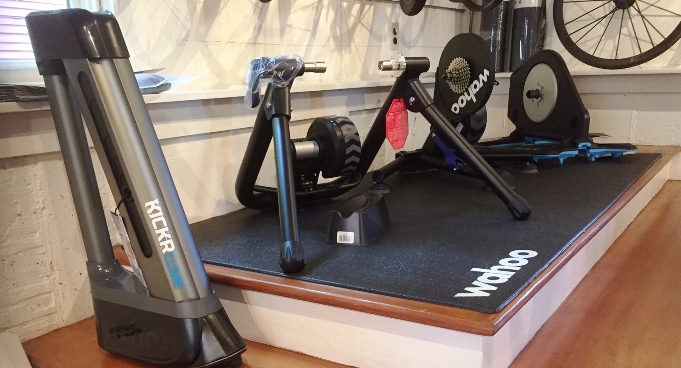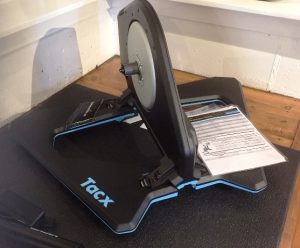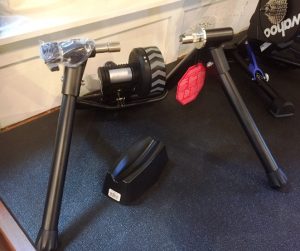Virtual Riding on an Indoor Smart Bike
I am admittedly late to the virtual riding/training experience. This being said, I’ve used CompuTrainer products (the original “smart” trainer) at work for decades and I’ve worked with different smart trainers from TACX, Wahoo and Saris/Cycleops through the years. However, until last winter, I did not ride a smart trainer consistently and had not experienced a variety of the compatible apps to fully experience their power. The old Kurt Kinetic Road Machine, along with old videos or some music, in a dark basement was the self-inflicted winter torture method that I would do most frequently. While this would often result in plenty of perspiration, it was never what I considered interesting. Each winter I would find myself avoiding riding the trainer more, resorting to short headlight equipped night runs or the like instead. The trainer simply wasn’t where I wanted to spend my workout time.
In 2020 the shop received its first batches of Stages and Wahoo indoor bikes. Offering the features and ride quality of the best smart trainers, but the adjustability of a gym based indoor bike, indoor bikes are a natural progression of the smart trainer concept. I was attracted to the small footprint and the ability for my wife and I to share a bike. When an extra unit became available, I decided the time had come for me to give the virtual riding experience of today a real evaluation.
Day One
I felt some risk bringing home a large and fairly heavy Wahoo Indoor Bike. At $3500, it isn’t exactly cheap and I didn’t know how my wife, Judy, was going to respond to technology entering her workouts to this level. She sometimes gravitates towards the luddite; the Wahoo was going to be a big step with something very different from her regiment of fluid trainer and Clinton era TV shows on Netflix. She agreed to try it though and I endeavored to set things up.
Indoor Smart Bike Initial Set-Up
Assembling the Wahoo Smart Bike from the crate is relatively straight-forward. Disposing of the pallet and other packing material took longer (and was more complicated) than bolting on the stabilizer legs and getting the handlebars and seatpost installed. All in all, set-up wasn’t a ten minute task, but it didn’t take an afternoon either.
Outside of the physical assembly, like any smart trainer, you need to get your initial settings into the bike with the native set-up app. I wanted to set the bike to mirror my current gravel road bike gearing and shift system (SRAM AXS set-up with “reverse” lever function). With only a little digging on the Wahoo settings app, I created my gearing and shift patterns and entered my personal information. I paired my phone to the bike and gave it a quick manual test – the gearing and resistance worked. Onto the next step.
Choosing a Ride Simulation App
Step two lets the smart trainer actually be “smart”. Using this unit in a simple erg mode and manual resistance seemed to defeat a notable portion of the purpose for me – to make things more entertaining and realistic. Because I tend to value realism of the ride experience over the social experience, I went with some trials from Rouvy and Fulgaz instead of jumping onto Zwift island.
Getting the apps set-up was pretty quick and straight-forward and I quickly took a short virtual 1 mile MTB ride somewhere in the U.K. to see if things worked. They did. However, as anticipated, this experience was going to benefit from a large screen in front of me instead of a phone or tablet – it was time to hook my device to the TV. This proved the most frustrating and time consuming part of set-up.
Wireless Video Feed on a TV
At the time of initial set-up, we had an Android phone and an iPhone in our household. I was able to get the iPhone to mirror wirelessly on the TV fairly quickly, but the Android was not happy. After buying multiple apps to interact with the Roku, I finally found a mirroring situation that functioned with the Android. Feeling like it was time to ride, I decided to go for my first real ride with a big screen. It was the proverbial “moment of truth”.
I selected a ride somewhere outside of Tucson, Arizona and started to pedal through the bright suburban sunshine – all from the inside of my 200+ year old stone basement in the midst of a Vermont winter’s night. Cool. However, what wasn’t so cool was that it became apparent quickly that my wireless was not up for the task of buffering and feeding high quality video to the TV at the rate needed. My video started cutting out and pausing. I stopped the ride, backed the video quality down a bunch, and started again. This stabilized the video, but also made it feel like I was riding in a big screen time warp – welcome to the 1993 smart trainer experience. A hardwired connection was clearly needed between the TV and the device.
Lacking an instant solution to the wiring issue, the video issues would have to be dealt with later. However, Arizona remained. I pedaled on and finished out my first ride in grainy pixeled splendor. This being said, even with the poor video, it was easy to appreciate how well the unit simulated the terrain and grade in the ride. The trainer and app did a great job mirroring what the video was showing and that was making a significant difference in the quality of the workout and how engaged I felt riding indoors.
Wired Video Feed
In early pandemic chaos, it took me three tries over a two week period, but I finally ordered the correct USB and HDMI adapters to allow Android and iOS phones to work on my circa 2012 television. This was the most frustrating part of my set-up experience. Some newer televisions and interface devices may have worked a lot easier with wireless than mine, but the hardwire was going to be my best option for running multiple accounts (my wife’s and mine) off different devices. Once I had the right wired adapters, things connected reliably and easily and I could jack the definition back up on the videos. This unleashed the true potential of the smart riding experience. Today, our connection is easy and stable.
With this in mind, it is worth thinking about your situation and how you are going to run and display your app of choice on the screen of your choice.
The Full Smart Trainer Experience
Fully equipped with a wired connection delivering a steady high definition stream, I selected a climb in Spain. As I started to ride out of the stucco lined town and up the grade with a couple other riders, I could instantly tell that the smart trainer was a huge step-forward. Equipped with HD video, I could see the hairs on the face of the cows beside the road as the grade increased. I sensed the ride, the day and the grade simulation mirroring what was being shown on the video. Really cool. While I can force myself through erg intervals as well as most people, the interactive trainer experience was simply way better. I finished the first “full ride” experience impressed and even looking forward to selecting my next ride location and doing it again. I never look forward to my next fluid trainer ride…
Next was the big test – what did Judy think? We logged into her account and she started a ride on the Mediterranean coast. I could tell that her reservations were diminishing with each pedal stroke and that she was enjoying the scenery. It was also apparent that the workout quality was likely better for her. Not having an option but to pedal up a 12% grade forces the issue in ways riding while watching a rerun of “Friends” just can’t. She was sold on it quicker than I thought.
Smart Trainer Accessory Features

While it sounds a bit gimmicky on the surface, we both found that we like the CLIMB feature of the Wahoo Indoor Bike. Like the CLIMB accessory for Wahoo’s smart trainers, the indoor bike tilts to simulate the angle of an ascent or descent in a ride. It made the experience more interactive. While I haven’t spent any quality time on it, I would assume that the same would be true with features like the TACX surface simulator that can simulate different road conditions.
Wahoo Indoor Bike Annoyances
In the interest of full disclosure, while the Wahoo Indoor Bike is extremely good, there are some minor places that could be improved. 1) The unit can sometimes creak a little under heavy loads. I’ve diminished this, but haven’t completely eliminated it, by retorquing everything. 2) The angle simulator feature has to be manually unlocked by hitting a button on the bike before/during each ride. It defaults to locked and it is easy to find yourself a mile in before realizing the physical angle simulator is not doing anything. It is easy to unlock it, but I’m not sure why it doesn’t default to unlocked in the first place.
While I’ve heard of people hitting their thighs on the wider main support of the trainer and the Wahoo bike doesn’t go as short as I would want out of the box for some smaller riders, neither my wife (who is 5’ 1”) or I had issue with these.
Smart Trainer Conclusions
While we used a Wahoo Indoor Bike, the experience offered by virtual ride apps like Rouvy, Fulgaz, etc. will be similar on any smart bike or smart trainer. Whether a dedicated indoor bike or your own steed attached to a smart trainer, harnessing the power of high definition video with actual resistance for a ride are powerful tools that can lead to more consistent workouts as well as improving motivation.
It is also great to be able to explore so much of the world’s rides from your own home. If you have ever wanted to ride renowned stages of a grand tour or one of the epic climbs on another continent or in another state, it is often just a few clicks away with a smart trainer and a good virtual ride app.

The Bottom Line: While every TV connection is different, getting your feed onto your TV will likely be the hardest part of getting going with your new smart trainer. However, once set-up and settled, I have a hard time imagining anyone who would not see significant benefit to the smart trainer experience compared to what a “dumb” trainer provides. The technology is powerful and can truly change your riding. We’ve seen that the biggest risk for some riders is that may no longer ride outside in the summer. The experience is that good. With smart trainers starting around $500, how long will you wait?
Contact us for more information about trainer options and to buy/order one today!

